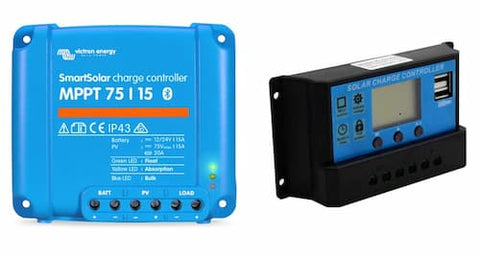
Which Solar Charger Controller Is for You: MPPT Vs PWM
Making the switch to solar-powered energy can be a great way to reduce your carbon footprint and save money on electric bills. One of the most important components of any successful installation is the solar charger controller; MPPT and PWM are two common types of solar charge controllers that play a crucial role in harnessing and managing solar energy efficiently. While PWM controllers are simpler and more cost-effective, MPPT controllers offer higher efficiency and better performance, especially in larger solar systems.
In this article blog, you will understand the differences and benefits of MPPT and PWM solar chargers. Also, you’ll realize why they are essential in making informed decisions when it comes to choosing the right controller for your specific solar setup.

What is MPPT?
MPPT, which stands for Maximum Power Point Tracking, is an advanced technology used in solar charge controllers. Its primary function is to optimize the output of solar panels by continuously tracking and adjusting to the maximum power point of the panel's voltage-current curve. This allows MPPT controllers to harvest the maximum amount of energy from the solar panels, especially in varying weather conditions in any part of your region.
Pros:
One of the significant advantages of MPPT is its higher efficiency compared to PWM (Pulse Width Modulation) controllers. MPPT controllers can convert more solar power into usable electricity, resulting in increased energy output and overall system performance. This increased efficiency translates into better charging capabilities, faster charging times, and higher energy harvest, making MPPT a popular choice for larger solar systems.
Another advantage of MPPT controllers is their ability to work with higher voltage panels. MPPT controllers can handle higher input voltages and convert them efficiently to the desired charging voltage, making them suitable for applications where multiple panels are connected in series or when using high-voltage panels. This flexibility allows for more design options and increased system scalability.
Cons:
However, MPPT controllers also have a few drawbacks. The main disadvantage is their higher cost compared to PWM controllers. Due to the advanced technology and additional circuitry required for maximum power point tracking, MPPT controllers tend to be more expensive as well. This higher cost may not be justified for smaller solar systems with a limited number of panels.
What is PWM?
PWM, or Pulse Width Modulation, is a simpler and more affordable technology used in solar charge controllers. PWM controllers regulate the charging process by rapidly switching the current flow to maintain a constant voltage. When the battery reaches the desired voltage, the PWM controller modulates the width of the charging pulses, reducing the power delivered to the battery.
Pros:
One of the significant advantages of PWM controllers is their cost-effectiveness. They are generally less expensive compared to MPPT controllers, making them a popular choice for smaller solar systems with fewer panels and those within a tight budget. Additionally, PWM controllers are relatively simple in design and operation, which contributes to being user-friendly.
PWM controllers are also known for their reliability and durability. With fewer components and a simpler circuit design, there are fewer potential points of failure, making PWM controllers less prone to malfunctions. They are often considered a robust and dependable option for solar charging.
Cons:
However, PWM controllers have some limitations compared to MPPT. One drawback is their lower efficiency. PWM controllers are not as effective at converting solar power into usable electricity compared to MPPT controllers. As a result, they may not be able to harvest the maximum amount of energy from solar panels, especially in conditions where there are fluctuations in solar irradiance.
Moreover, PWM controllers are not ideal for applications with higher voltage panels or systems with multiple panels connected in series. They are designed to work with lower voltage panels and may not efficiently convert the higher input voltages. This can limit the scalability and design options for solar systems utilizing PWM controllers.
MPPT VS PWM: Which is Better?
When it comes to choosing a solar charge controller, the decision between MPPT (Maximum Power Point Tracking) and PWM (Pulse Width Modulation) depends on various factors. Each technology has its own advantages and considerations, and understanding their differences will help you make an informed decision for your solar system.
To summarize, here are the key considerations for choosing between MPPT and PWM controllers:
System Size
MPPT controllers are more suitable for larger solar systems with multiple panels or high-voltage panels. PWM controllers are a cost-effective option for smaller systems with fewer panels.
Efficiency
MPPT controllers have higher efficiency, leading to increased energy output and faster charging times. PWM controllers are less efficient but still provide reliable charging capabilities.
Cost
MPPT controllers are generally more expensive due to their advanced technology and increased efficiency. PWM controllers offer a more budget-friendly option.
Scalability
MPPT controllers offer more design options and scalability, making them ideal for expanding solar systems. PWM controllers have limitations when it comes to higher voltage panels or systems with multiple panels in series.
Ultimately, the choice between MPPT and PWM controllers depends on your specific requirements, budget, and system size. It's important to evaluate these factors and consider the long-term benefits and efficiency gains associated with each technology. Consulting with a solar professional can also provide valuable insights and recommendations based on your unique needs.
All-in-one Energy Solution: Anker Powerhouse

The Anker PowerHouse is an innovative and versatile all-in-one energy solution that eliminates the need for additional hardware such as MPPT or PWM controllers. Designed to provide a convenient and portable power source, the Anker 767 PowerHouse combines a high-capacity battery, AC outlets, USB ports, and DC inputs/outputs in a single device.
With its robust battery capacity and multiple charging options, the Anker PowerHouse can efficiently power various devices and appliances, making it perfect for outdoor activities, emergencies, and off-grid living. The built-in AC outlets allow you to plug in standard household appliances, while the USB ports provide convenient charging for smartphones, tablets, and other electronic devices. Additionally, the DC inputs/outputs enable compatibility with solar panels, allowing you to recharge the PowerHouse using clean, renewable energy.
The Anker PowerHouse offers a compact and user-friendly design, making it easy to transport and use in various settings. Its all-in-one functionality eliminates the need for separate components, simplifying the setup process and reducing costs. Whether you're camping, traveling, or facing power outages, the Anker PowerHouse provides a reliable and convenient solution for your energy needs.
Conclusion
Both MPPT and PWM solar charge controllers have their advantages and considerations. MPPT controllers offer higher efficiency, faster charging times, and increased energy harvest, making them suitable for larger solar systems. PWM controllers provide a cost-effective and reliable solution for smaller systems. By understanding the differences and evaluating your system requirements, you can make an informed choice and optimize the performance of your solar system. But if you want an all-in-one choice, you can choose Anker 767 PowerHouse. With this revolutionary technology, you can rest assured that your panels will be receiving just the right amount of energy, without any additional hardware fuss.















